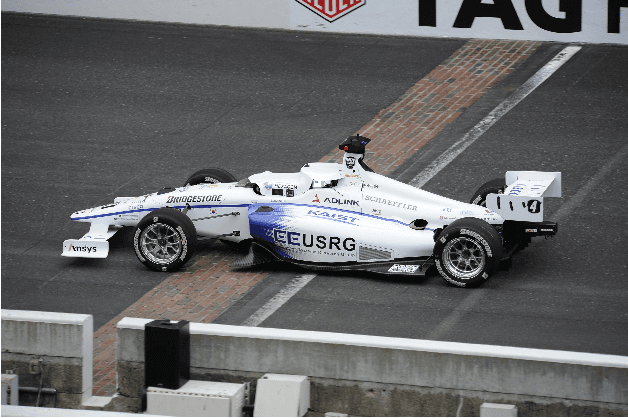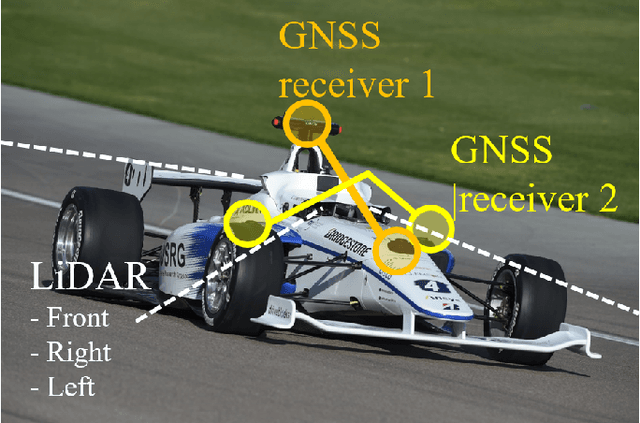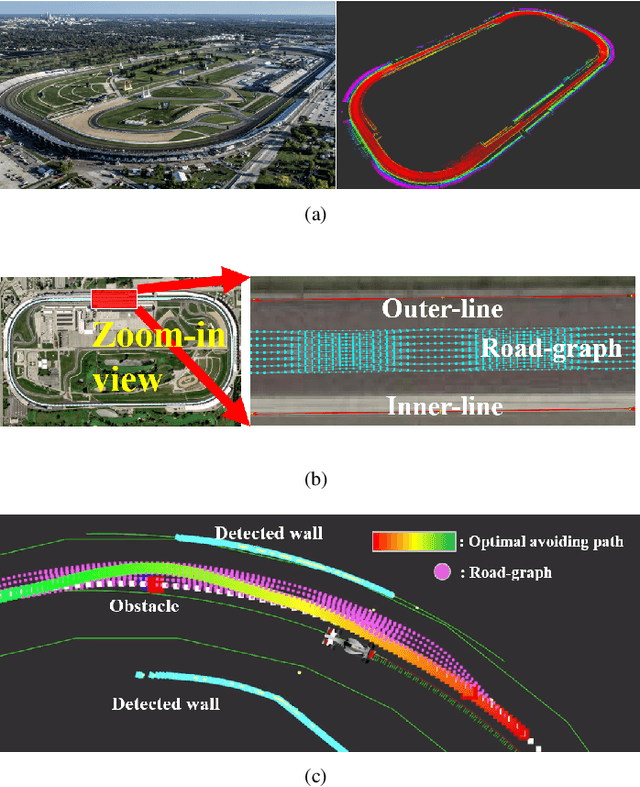Hyunki Seong
Learning from Demonstration with Hierarchical Policy Abstractions Toward High-Performance and Courteous Autonomous Racing
Nov 07, 2024



Abstract:Fully autonomous racing demands not only high-speed driving but also fair and courteous maneuvers. In this paper, we propose an autonomous racing framework that learns complex racing behaviors from expert demonstrations using hierarchical policy abstractions. At the trajectory level, our policy model predicts a dense distribution map indicating the likelihood of trajectories learned from offline demonstrations. The maximum likelihood trajectory is then passed to the control-level policy, which generates control inputs in a residual fashion, considering vehicle dynamics at the limits of performance. We evaluate our framework in a high-fidelity racing simulator and compare it against competing baselines in challenging multi-agent adversarial scenarios. Quantitative and qualitative results show that our trajectory planning policy significantly outperforms the baselines, and the residual control policy improves lap time and tracking accuracy. Moreover, challenging closed-loop experiments with ten opponents show that our framework can overtake other vehicles by understanding nuanced interactions, effectively balancing performance and courtesy like professional drivers.
Words to Wheels: Vision-Based Autonomous Driving Understanding Human Language Instructions Using Foundation Models
Oct 14, 2024



Abstract:This paper introduces an innovative application of foundation models, enabling Unmanned Ground Vehicles (UGVs) equipped with an RGB-D camera to navigate to designated destinations based on human language instructions. Unlike learning-based methods, this approach does not require prior training but instead leverages existing foundation models, thus facilitating generalization to novel environments. Upon receiving human language instructions, these are transformed into a 'cognitive route description' using a large language model (LLM)-a detailed navigation route expressed in human language. The vehicle then decomposes this description into landmarks and navigation maneuvers. The vehicle also determines elevation costs and identifies navigability levels of different regions through a terrain segmentation model, GANav, trained on open datasets. Semantic elevation costs, which take both elevation and navigability levels into account, are estimated and provided to the Model Predictive Path Integral (MPPI) planner, responsible for local path planning. Concurrently, the vehicle searches for target landmarks using foundation models, including YOLO-World and EfficientViT-SAM. Ultimately, the vehicle executes the navigation commands to reach the designated destination, the final landmark. Our experiments demonstrate that this application successfully guides UGVs to their destinations following human language instructions in novel environments, such as unfamiliar terrain or urban settings.
Skill Q-Network: Learning Adaptive Skill Ensemble for Mapless Navigation in Unknown Environments
Mar 25, 2024Abstract:This paper focuses on the acquisition of mapless navigation skills within unknown environments. We introduce the Skill Q-Network (SQN), a novel reinforcement learning method featuring an adaptive skill ensemble mechanism. Unlike existing methods, our model concurrently learns a high-level skill decision process alongside multiple low-level navigation skills, all without the need for prior knowledge. Leveraging a tailored reward function for mapless navigation, the SQN is capable of learning adaptive maneuvers that incorporate both exploration and goal-directed skills, enabling effective navigation in new environments. Our experiments demonstrate that our SQN can effectively navigate complex environments, exhibiting a 40% higher performance compared to baseline models. Without explicit guidance, SQN discovers how to combine low-level skill policies, showcasing both goal-directed navigations to reach destinations and exploration maneuvers to escape from local minimum regions in challenging scenarios. Remarkably, our adaptive skill ensemble method enables zero-shot transfer to out-of-distribution domains, characterized by unseen observations from non-convex obstacles or uneven, subterranean-like environments.
Topological Exploration using Segmented Map with Keyframe Contribution in Subterranean Environments
Sep 15, 2023



Abstract:Existing exploration algorithms mainly generate frontiers using random sampling or motion primitive methods within a specific sensor range or search space. However, frontiers generated within constrained spaces lead to back-and-forth maneuvers in large-scale environments, thereby diminishing exploration efficiency. To address this issue, we propose a method that utilizes a 3D dense map to generate Segmented Exploration Regions (SERs) and generate frontiers from a global-scale perspective. In particular, this paper presents a novel topological map generation approach that fully utilizes Line-of-Sight (LOS) features of LiDAR sensor points to enhance exploration efficiency inside large-scale subterranean environments. Our topological map contains the contributions of keyframes that generate each SER, enabling rapid exploration through a switch between local path planning and global path planning to each frontier. The proposed method achieved higher explored volume generation than the state-of-the-art algorithm in a large-scale simulation environment and demonstrated a 62% improvement in explored volume increment performance. For validation, we conducted field tests using UAVs in real subterranean environments, demonstrating the efficiency and speed of our method.
TempFuser: Learning Tactical and Agile Flight Maneuvers in Aerial Dogfights using a Long Short-Term Temporal Fusion Transformer
Aug 07, 2023Abstract:Aerial dogfights necessitate understanding the tactically changing maneuvers from a long-term perspective, along with the rapidly changing aerodynamics from a short-term view. In this paper, we propose a novel long short-term temporal fusion transformer (TempFuser) for a policy network in aerial dogfights. Our method uses two LSTM-based input embeddings to encode long-term, sparse state trajectories, as well as short-term, dense state trajectories. By integrating the two embeddings through a transformer encoder, the method subsequently derives end-to-end flight commands for agile and tactical maneuvers. We formulate a deep reinforcement learning framework to train our TempFuser-based policy model. We then extensively validate our model, demonstrating that it outperforms other baseline models against a diverse range of opponent aircraft in a high-fidelity environment. Our model successfully learns basic fighter maneuvers, human pilot-like tactical maneuvers, and robust supersonic pursuit in low altitudes without explicitly coded prior knowledge. Videos are available at \url{https://sites.google.com/view/tempfuser}
A Versatile Door Opening System with Mobile Manipulator through Adaptive Position-Force Control and Reinforcement Learning
Jul 10, 2023Abstract:The ability of robots to navigate through doors is crucial for their effective operation in indoor environments. Consequently, extensive research has been conducted to develop robots capable of opening specific doors. However, the diverse combinations of door handles and opening directions necessitate a more versatile door opening system for robots to successfully operate in real-world environments. In this paper, we propose a mobile manipulator system that can autonomously open various doors without prior knowledge. By using convolutional neural networks, point cloud extraction techniques, and external force measurements during exploratory motion, we obtained information regarding handle types, poses, and door characteristics. Through two different approaches, adaptive position-force control and deep reinforcement learning, we successfully opened doors without precise trajectory or excessive external force. The adaptive position-force control method involves moving the end-effector in the direction of the door opening while responding compliantly to external forces, ensuring safety and manipulator workspace. Meanwhile, the deep reinforcement learning policy minimizes applied forces and eliminates unnecessary movements, enabling stable operation across doors with different poses and widths. The RL-based approach outperforms the adaptive position-force control method in terms of compensating for external forces, ensuring smooth motion, and achieving efficient speed. It reduces the maximum force required by 3.27 times and improves motion smoothness by 1.82 times. However, the non-learning-based adaptive position-force control method demonstrates more versatility in opening a wider range of doors, encompassing revolute doors with four distinct opening directions and varying widths.
An Autonomous System for Head-to-Head Race: Design, Implementation and Analysis; Team KAIST at the Indy Autonomous Challenge
Mar 16, 2023Abstract:While the majority of autonomous driving research has concentrated on everyday driving scenarios, further safety and performance improvements of autonomous vehicles require a focus on extreme driving conditions. In this context, autonomous racing is a new area of research that has been attracting considerable interest recently. Due to the fact that a vehicle is driven by its perception, planning, and control limits during racing, numerous research and development issues arise. This paper provides a comprehensive overview of the autonomous racing system built by team KAIST for the Indy Autonomous Challenge (IAC). Our autonomy stack consists primarily of a multi-modal perception module, a high-speed overtaking planner, a resilient control stack, and a system status manager. We present the details of all components of our autonomy solution, including algorithms, implementation, and unit test results. In addition, this paper outlines the design principles and the results of a systematical analysis. Even though our design principles are derived from the unique application domain of autonomous racing, they can also be applied to a variety of safety-critical, high-cost-of-failure robotics applications. The proposed system was integrated into a full-scale autonomous race car (Dallara AV-21) and field-tested extensively. As a result, team KAIST was one of three teams who qualified and participated in the official IAC race events without any accidents. Our proposed autonomous system successfully completed all missions, including overtaking at speeds of around $220 km/h$ in the IAC@CES2022, the world's first autonomous 1:1 head-to-head race.
Data-Driven Model Identification via Hyperparameter Optimization for Autonomous Racing Systems
Jan 06, 2023Abstract:In this letter, we propose a model identification method via hyperparameter optimization (MIHO). Our method adopts an efficient explore-exploit strategy to identify the parameters of dynamic models in a data-driven optimization manner. We utilize MIHO for model parameter identification of the AV-21, a full-scaled autonomous race vehicle. We then incorporate the optimized parameters for the design of model-based planning and control systems of our platform. In experiments, the learned parametric models demonstrate good fitness to given datasets and show generalization ability in unseen dynamic scenarios. We further conduct extensive field tests to validate our model-based system. The tests show that our race systems leverage the learned model dynamics and successfully perform obstacle avoidance and high-speed driving over $200 km/h$ at the Indianapolis Motor Speedway and Las Vegas Motor Speedway. The source code for MIHO and videos of the tests are available at https://github.com/hynkis/MIHO.
Design, Field Evaluation, and Traffic Analysis of a Competitive Autonomous Driving Model in a Congested Environment
Nov 07, 2022



Abstract:Recently, numerous studies have investigated cooperative traffic systems using the communication among vehicle-to-everything (V2X). Unfortunately, when multiple autonomous vehicles are deployed while exposed to communication failure, there might be a conflict of ideal conditions between various autonomous vehicles leading to adversarial situation on the roads. In South Korea, virtual and real-world urban autonomous multi-vehicle races were held in March and November of 2021, respectively. During the competition, multiple vehicles were involved simultaneously, which required maneuvers such as overtaking low-speed vehicles, negotiating intersections, and obeying traffic laws. In this study, we introduce a fully autonomous driving software stack to deploy a competitive driving model, which enabled us to win the urban autonomous multi-vehicle races. We evaluate module-based systems such as navigation, perception, and planning in real and virtual environments. Additionally, an analysis of traffic is performed after collecting multiple vehicle position data over communication to gain additional insight into a multi-agent autonomous driving scenario. Finally, we propose a method for analyzing traffic in order to compare the spatial distribution of multiple autonomous vehicles. We study the similarity distribution between each team's driving log data to determine the impact of competitive autonomous driving on the traffic environment.
Resilient Navigation and Path Planning System for High-speed Autonomous Race Car
Jul 25, 2022



Abstract:This paper describes resilient navigation and planning algorithm for high-speed autonomous race, Indy Autonomous Challenge (IAC). The IAC is a competition with full-scale autonomous race car that can drive up to 290 km/h(180mph). Due to its high-speed and heavy vibration of the race car, GPS/INS system is prone to be degraded. These degraded GPS measurements can cause a critical localization error leading to a serious crashing accidents. To this end, we propose a robust navigation system to implement multi-sensor fusion Kalman filter. In this study, we present how to identify the degradation of measurement based on probabilistic approaches. Based on this approach, we could compute optimal measurement values for Kalman filter correction step. At the same time, we present the other resilient navigation system so that race car can follow the race track in fatal localization failure situations. In addition, this paper also covers the optimal path planning algorithm for obstacle avoidance. To take account for original optimal racing line, obstacles, vehicle dynamics, we propose a road-graph-based path planning algorithm to guarantee our race car drives in-bounded conditions. In the experiments, we will evaluate our designed localization system can handle the degraded data, and sometimes prevent serious crashing accidents while high-speed driving. In addition, we will describe how we successfully completed the obstacle avoidance challenge.
 Add to Chrome
Add to Chrome Add to Firefox
Add to Firefox Add to Edge
Add to Edge